-
![[Charles Octave Moget, Joseph Décembre]. Sempronius. Histoire de la Commune de Paris en 1871. Paris, Décembre-Alonnier, [1871]. – pp: [i, ii - ht, imprim.] iii, iv - t.p., blank] [v - table] vi-viii (viii numbered iii), [1] 2 [3] 4-267 [268 blank] [1] 2-12 advert. [Pseudonym of Charles Octave Moget and Joseph Décembre]. Charles Octave Moget, dit Octave Féré (1815-1875); Joseph Décembre, dit Décembre-Allonier (1836 – 1906).](https://varshavskycollection.com/wp-content/uploads/2021/02/LIB-2445.2020-a-1-500x500.jpeg) Front publisher’s yellow wrapper, in a double frame: SEMPRONIUS | HISTOIRE | DE LA | COMMUNE DE PARIS | EN 1871 | La période impériale. – La Révolution du 4 Septembre. – Le | gouvernement de la Défense nationale. – Le Parti républicain | et le Parti socialiste. – L'Association internationale des | travailleurs. – Menées du parti socialiste. – La Commune en 1793. – Le 31 octobre et le 22 janvier. – La Capitulation de | Paris. – Le 18 mars. – L'Assassinat des généraux Clément | Thomas et Lecomte. – Le Comité central de la Garde nationale. | – La Commune ; – Ses Agissement. – Son Budget. – La | Terreur. – Insolence des Fédérés. – Les journaux. – Les Otages. | – Les Opérations militaires. – Les Fusillades. – Les Vols. – Les | Barricades. – Les Incendies. – Documents officiels de la Commune. | TROISIÈME ÉDITION | PARIS, DECEMBRE - ALONNIER, LIBRAIRE-ÉDITEUR | 20 RUE SEGUR, 20 | PRÉS DE LA PLACE SAINT-ANDR -DES-ARTS || Title page: similar to the cover with no frame. Pagination: front wrapper, [2] – h.t. / imprint., [2] – t.p. / blank, [i] – table de matières, vi (i.e. ii), vii (i.e. iii), iii (i.e. iv), [1] 2-267 [268 blank], [1] 2-12 – publisher's advert., back wrapper. Collation : 18mo ; π4, 1-1518, ß6. Binding: 18.5 x 12 cm; softcover; original yellow wrappers, black lettering to covers and spine; almost disbound. Réferences: Le Quillec (1997): 2324; University of Sussex > Paris Commune Collection. Author of the book: "SEMPRONIUS" was in reality two men: Moget, Charles Octave [Féré, Octave] (French, 1815 – 1875) and Décembre, Joseph [Décembre-Allonier] (French, 1836 – 1906).
Front publisher’s yellow wrapper, in a double frame: SEMPRONIUS | HISTOIRE | DE LA | COMMUNE DE PARIS | EN 1871 | La période impériale. – La Révolution du 4 Septembre. – Le | gouvernement de la Défense nationale. – Le Parti républicain | et le Parti socialiste. – L'Association internationale des | travailleurs. – Menées du parti socialiste. – La Commune en 1793. – Le 31 octobre et le 22 janvier. – La Capitulation de | Paris. – Le 18 mars. – L'Assassinat des généraux Clément | Thomas et Lecomte. – Le Comité central de la Garde nationale. | – La Commune ; – Ses Agissement. – Son Budget. – La | Terreur. – Insolence des Fédérés. – Les journaux. – Les Otages. | – Les Opérations militaires. – Les Fusillades. – Les Vols. – Les | Barricades. – Les Incendies. – Documents officiels de la Commune. | TROISIÈME ÉDITION | PARIS, DECEMBRE - ALONNIER, LIBRAIRE-ÉDITEUR | 20 RUE SEGUR, 20 | PRÉS DE LA PLACE SAINT-ANDR -DES-ARTS || Title page: similar to the cover with no frame. Pagination: front wrapper, [2] – h.t. / imprint., [2] – t.p. / blank, [i] – table de matières, vi (i.e. ii), vii (i.e. iii), iii (i.e. iv), [1] 2-267 [268 blank], [1] 2-12 – publisher's advert., back wrapper. Collation : 18mo ; π4, 1-1518, ß6. Binding: 18.5 x 12 cm; softcover; original yellow wrappers, black lettering to covers and spine; almost disbound. Réferences: Le Quillec (1997): 2324; University of Sussex > Paris Commune Collection. Author of the book: "SEMPRONIUS" was in reality two men: Moget, Charles Octave [Féré, Octave] (French, 1815 – 1875) and Décembre, Joseph [Décembre-Allonier] (French, 1836 – 1906). -
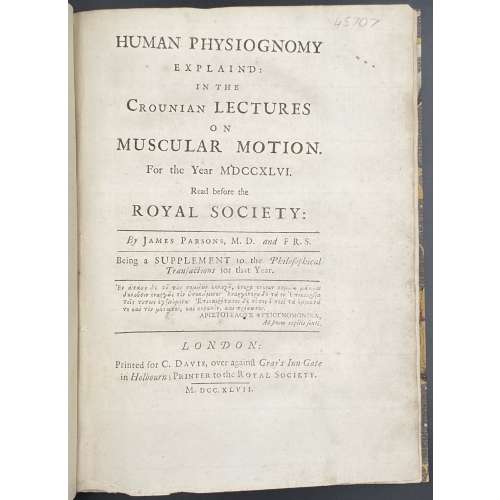 HUMAN PHYSIOGNOMY | EXPLAIN'D: | IN THE | Crounian LECTURES | ON MUSCULAR MOTION. | For the Year MDCCXLVI. | Read before the | ROYAL SOCIETY: | By James Parsons, M.D. and F.R.S. | Being a SUPPLEMENT to the Philosophical | Transactions for that Year. | {Citation in the Greek from Aristotle, 6 lines} | LONDON: | Printed for C. Davis, over against Gray's Inn Gate | in Holbourn; Printer to the Royal Society. | M. DCC. XLVII. || Pagination: [4] i-viii [8] 1-82 [4]; collation: 4to; [a]4 b4 c2 <inset> B-L4 M3, wanting 1 leaf with An Index For the Lectures of the Years 1744, and 1745; Inset: 5 folding plates engraved by J. Mynde after J. Parsons ('I. Ps. MD del.'). Page 22.5 x 16.5 cm; plates 22.5 x 34 cm. Printed on laid paper, with tall "s". Binding: 23 x 17 cm, modern hardcover in marbled paper, modern endpapers, white paper label with black lettering to spine. Crounian Lectures (i.e. Croonian Lectures), named after William Croone (British, 1633 – 1684). Contributors: James Parsons (British, 1705 – 1770). James Mynde (British, 1702 – 1771). Davis, Printer to the Royal Society of London (British, 1665 – 1775). Ref.: Royal Academy, The Royal Society, Wellcome Collection.
HUMAN PHYSIOGNOMY | EXPLAIN'D: | IN THE | Crounian LECTURES | ON MUSCULAR MOTION. | For the Year MDCCXLVI. | Read before the | ROYAL SOCIETY: | By James Parsons, M.D. and F.R.S. | Being a SUPPLEMENT to the Philosophical | Transactions for that Year. | {Citation in the Greek from Aristotle, 6 lines} | LONDON: | Printed for C. Davis, over against Gray's Inn Gate | in Holbourn; Printer to the Royal Society. | M. DCC. XLVII. || Pagination: [4] i-viii [8] 1-82 [4]; collation: 4to; [a]4 b4 c2 <inset> B-L4 M3, wanting 1 leaf with An Index For the Lectures of the Years 1744, and 1745; Inset: 5 folding plates engraved by J. Mynde after J. Parsons ('I. Ps. MD del.'). Page 22.5 x 16.5 cm; plates 22.5 x 34 cm. Printed on laid paper, with tall "s". Binding: 23 x 17 cm, modern hardcover in marbled paper, modern endpapers, white paper label with black lettering to spine. Crounian Lectures (i.e. Croonian Lectures), named after William Croone (British, 1633 – 1684). Contributors: James Parsons (British, 1705 – 1770). James Mynde (British, 1702 – 1771). Davis, Printer to the Royal Society of London (British, 1665 – 1775). Ref.: Royal Academy, The Royal Society, Wellcome Collection. -
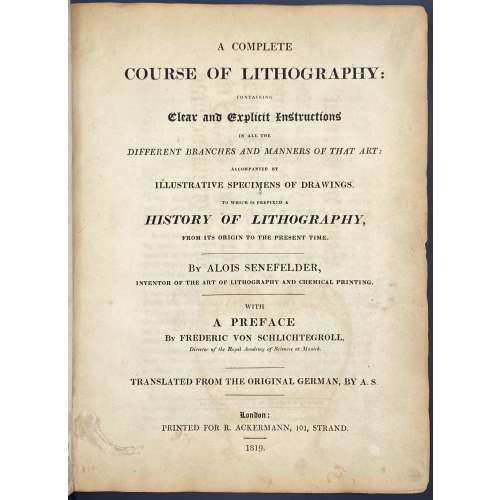 Title: A COMPLETE | COURSE OF LITHOGRAPHY: | CONTAINING | Clear and Explicit Instructions | IN ALL THE | DIFFERENT BRANCHES AND MANNERS OF THAT ART | ACCOMPANIED BY | ILLUSTRATIVE SPECIMENS OF DRAWINGS. | TO WHICH IS PREFIXED A | HISTORY OF LITHOGRAPHY, | FROM ITS ORIGIN TO THE PRESENT TIME. | By ALOIS SENEFELDER, | INVENTOR OF THE ART OF LITHOGRAPHY AND CHEMICAL PRINTING. | WITH | A PREFACE | By FREDERIC VON SCHLICHTEGROLL, |Director of the Royal Academy of Sciences at Munich. | TRANSLATED FROM THE ORIGINAL GERMAN, BY A.S. | London: | PRINTED FOR R. ACKERMANN, 101 STRAND. | 1819. || Pagination: [i-iii] iv-xxviii, [4] [1] 2-342. Collation: 4to; [a]-d4, B-2U4 2X2, +14 lithographed plates by Ackermann (incl. 1 folding, 1 colour frontispiece and 1 portrait of A. Senefelder); plates opposite to pp. [i], [1], 193, 198, 203, 228, 232 (fold.), 256, 258, 264, 269, 290, 302, and 305. Binding: By Anne Krawitz (Philadelphia, PA), 27.5 x 21 cm, modern full mottled calf, boards ruled in gilt, flat spine, compartments ruled in gilt, crimson label with gilt lettering to spine, printed on wove paper; round book-plate to front paste-down “TWM, The Whitehead Library”. Edition: 1st in English. Ref.: MET: Accession Number: Ref.20; RCT: RCIN 1195886; Contributors: Alois Senefelder (German, 1771 – 1834) – author of the original and translator. Friedrich Schlichtegroll (German, 1765 – 1822) – author of preface. William Clowes (British, 1779 – 1847) – printer. Rudolph Ackermann (German-British, 1764 – 1834) – publisher and lithographer. Samuel Prout (British, 1783 – 1852) Maximilian Joseph, King of Bavaria (German, 1756 –1825) – dedicatee.
Title: A COMPLETE | COURSE OF LITHOGRAPHY: | CONTAINING | Clear and Explicit Instructions | IN ALL THE | DIFFERENT BRANCHES AND MANNERS OF THAT ART | ACCOMPANIED BY | ILLUSTRATIVE SPECIMENS OF DRAWINGS. | TO WHICH IS PREFIXED A | HISTORY OF LITHOGRAPHY, | FROM ITS ORIGIN TO THE PRESENT TIME. | By ALOIS SENEFELDER, | INVENTOR OF THE ART OF LITHOGRAPHY AND CHEMICAL PRINTING. | WITH | A PREFACE | By FREDERIC VON SCHLICHTEGROLL, |Director of the Royal Academy of Sciences at Munich. | TRANSLATED FROM THE ORIGINAL GERMAN, BY A.S. | London: | PRINTED FOR R. ACKERMANN, 101 STRAND. | 1819. || Pagination: [i-iii] iv-xxviii, [4] [1] 2-342. Collation: 4to; [a]-d4, B-2U4 2X2, +14 lithographed plates by Ackermann (incl. 1 folding, 1 colour frontispiece and 1 portrait of A. Senefelder); plates opposite to pp. [i], [1], 193, 198, 203, 228, 232 (fold.), 256, 258, 264, 269, 290, 302, and 305. Binding: By Anne Krawitz (Philadelphia, PA), 27.5 x 21 cm, modern full mottled calf, boards ruled in gilt, flat spine, compartments ruled in gilt, crimson label with gilt lettering to spine, printed on wove paper; round book-plate to front paste-down “TWM, The Whitehead Library”. Edition: 1st in English. Ref.: MET: Accession Number: Ref.20; RCT: RCIN 1195886; Contributors: Alois Senefelder (German, 1771 – 1834) – author of the original and translator. Friedrich Schlichtegroll (German, 1765 – 1822) – author of preface. William Clowes (British, 1779 – 1847) – printer. Rudolph Ackermann (German-British, 1764 – 1834) – publisher and lithographer. Samuel Prout (British, 1783 – 1852) Maximilian Joseph, King of Bavaria (German, 1756 –1825) – dedicatee. -
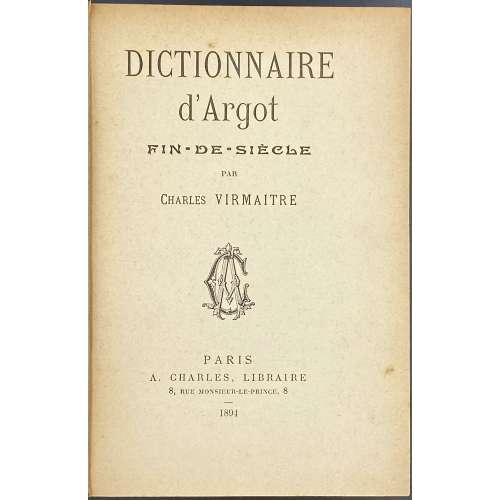 DICTIONNAIRE | d'Argot | FIN-DE-SIÈCLE | PAR | Charles VIRMAITRE | {publisher's device "A.C."} | PARIS | A. CHARLES, LIBRAIRE | 8, RUE MONSIEUR-LE-PRINCE, 8 | 1894 || Pagination : [i-ix] x-xxiii [xxiv blank] [1] 2-336 + [3] 6-176; note: in Supplement – before page 6 only 3 pages. Collation: π4 ii8 [1]-1718 196 (180 leaves) + [1]17 3-[7]18 916 (87 leaves). Binding: Brown cloth, blind double-fillets, gilt lettering to the title.
DICTIONNAIRE | d'Argot | FIN-DE-SIÈCLE | PAR | Charles VIRMAITRE | {publisher's device "A.C."} | PARIS | A. CHARLES, LIBRAIRE | 8, RUE MONSIEUR-LE-PRINCE, 8 | 1894 || Pagination : [i-ix] x-xxiii [xxiv blank] [1] 2-336 + [3] 6-176; note: in Supplement – before page 6 only 3 pages. Collation: π4 ii8 [1]-1718 196 (180 leaves) + [1]17 3-[7]18 916 (87 leaves). Binding: Brown cloth, blind double-fillets, gilt lettering to the title. -
![Аполлон Григорьев. Воспоминания / Ред. и коммент. Иванова-Разумника. Супер-обложка худ. В. М. Конашевича, тиснение на переплете худ. А. А. Ушина. – М., Л.: Academia, 1930. – (Памятники литературного быта. Воспоминания Аполлона Григорьева и воспоминания о нем). – Тир. 5070 экз. – pp.: [i-v] vi-viii, [1-3] 4-697 [3].](https://varshavskycollection.com/wp-content/uploads/2021/02/LIB-2532.2020-a-500x500.jpeg) Title page: АПОЛЛОН ГРИГОРЬЕВ | ВОСПОМИНАНИЯ | РЕДАКЦИЯ И КОММЕНТАРИИ | ИВАНОВА – РАЗУМНИКА | « ACADEMIA» | МОСКВА — ЛЕНИНГРАД | 1930 || Duplicate title: ПАМЯТНИКИ | ЛИТЕРАТУРНОГО | БЫТА | ВОСПОМИНАНИЯ | АПОЛЛОНА ГРИГОРЬЕВА | И ВОСПОМИНАНИЯ О НЕМ | «ACADEMIA» | МОСКВА — ЛЕНИНГРАД | 1930 || Title verso: Супер-обложка | худ. В. М. Конашевича | Тиснение на переплете | худ. А. А. Ушина | {imprint} || Print run: 5070 copies. Pagination: [i-v] vi-viii, [1-3] 4-697 [3]. Collation: 8vo; π4, 1-428, Ω14 (total 345 leaves) + 1 plate (photomechanical portrait frontispiece). Note: 11 unsigned. Binding: 18 x 13 cm; purple cloth, gilt-stamped with geometrical design, gilt lettering to spine, pictorial DJ (short, 16 cm). Catalogue raisonné: Крылов-Кичатова (2004): № 403, p.210. Григорьев, Аполлон Александрович (Russian, 1822 – 1864) – character, author. Конашевич, Владимир Михайлович (Russian, 1888 – 1963) – artist. Ушин, Алексей Алексеевич (Russian, 1904 – 1942) – artist.
Title page: АПОЛЛОН ГРИГОРЬЕВ | ВОСПОМИНАНИЯ | РЕДАКЦИЯ И КОММЕНТАРИИ | ИВАНОВА – РАЗУМНИКА | « ACADEMIA» | МОСКВА — ЛЕНИНГРАД | 1930 || Duplicate title: ПАМЯТНИКИ | ЛИТЕРАТУРНОГО | БЫТА | ВОСПОМИНАНИЯ | АПОЛЛОНА ГРИГОРЬЕВА | И ВОСПОМИНАНИЯ О НЕМ | «ACADEMIA» | МОСКВА — ЛЕНИНГРАД | 1930 || Title verso: Супер-обложка | худ. В. М. Конашевича | Тиснение на переплете | худ. А. А. Ушина | {imprint} || Print run: 5070 copies. Pagination: [i-v] vi-viii, [1-3] 4-697 [3]. Collation: 8vo; π4, 1-428, Ω14 (total 345 leaves) + 1 plate (photomechanical portrait frontispiece). Note: 11 unsigned. Binding: 18 x 13 cm; purple cloth, gilt-stamped with geometrical design, gilt lettering to spine, pictorial DJ (short, 16 cm). Catalogue raisonné: Крылов-Кичатова (2004): № 403, p.210. Григорьев, Аполлон Александрович (Russian, 1822 – 1864) – character, author. Конашевич, Владимир Михайлович (Russian, 1888 – 1963) – artist. Ушин, Алексей Алексеевич (Russian, 1904 – 1942) – artist. -
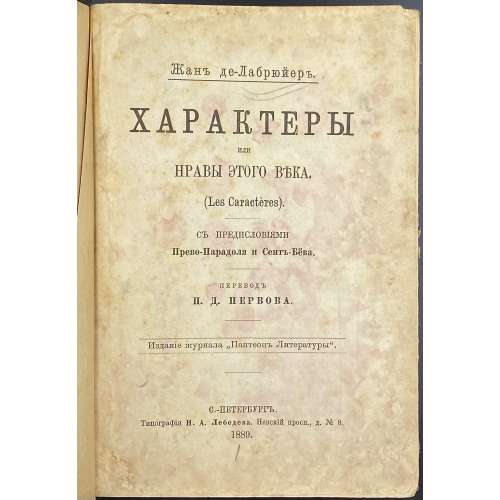 Title page: Жанъ де Лабрюйеръ. | ХАРАКТЕРЫ | ИЛИ | НРАВЫ ЭТОГО ВѢКА. | (Les Caractères). | СЪ ПРЕДИСЛОВIЯМИ | Прево-Парадоля и Сентъ-Бёва. | ПЕРЕВОДЪ | П. Д. ПЕРВОВА. | {in waving rules} Изданiе журнала "Пантеонъ Литературы". | С.-ПЕТЕРБУРГ. | Типографiя Н. А. Лебедева. Невскiй просп., д. № 8. | 1889. || Pagination: [1-3] 4-371 [372] – handwritten contents, green ballpen; total 372 pages. Collation: 8vo; 1-238 ¼242, total 186 leaves. Binding: 24 x 16.5 cm, owner’s quarter cloth over marbled boards. Contributors: Jean de La Bruyère (French, 1645 – 1696) – author. Sainte-Beuve, Charles Augustin (French, 1804 – 1869) – author of the foreword. Prévost-Paradol, Lucien-Anatole (French, 1829 – 1870) – – author of the foreword. Первов, Павел Дмитриевич (Russian, 1860 – 1929) – translator. Лебедев, Николай Афанасьевич (Russian, 1813 – 1896) – printer.
Title page: Жанъ де Лабрюйеръ. | ХАРАКТЕРЫ | ИЛИ | НРАВЫ ЭТОГО ВѢКА. | (Les Caractères). | СЪ ПРЕДИСЛОВIЯМИ | Прево-Парадоля и Сентъ-Бёва. | ПЕРЕВОДЪ | П. Д. ПЕРВОВА. | {in waving rules} Изданiе журнала "Пантеонъ Литературы". | С.-ПЕТЕРБУРГ. | Типографiя Н. А. Лебедева. Невскiй просп., д. № 8. | 1889. || Pagination: [1-3] 4-371 [372] – handwritten contents, green ballpen; total 372 pages. Collation: 8vo; 1-238 ¼242, total 186 leaves. Binding: 24 x 16.5 cm, owner’s quarter cloth over marbled boards. Contributors: Jean de La Bruyère (French, 1645 – 1696) – author. Sainte-Beuve, Charles Augustin (French, 1804 – 1869) – author of the foreword. Prévost-Paradol, Lucien-Anatole (French, 1829 – 1870) – – author of the foreword. Первов, Павел Дмитриевич (Russian, 1860 – 1929) – translator. Лебедев, Николай Афанасьевич (Russian, 1813 – 1896) – printer. -
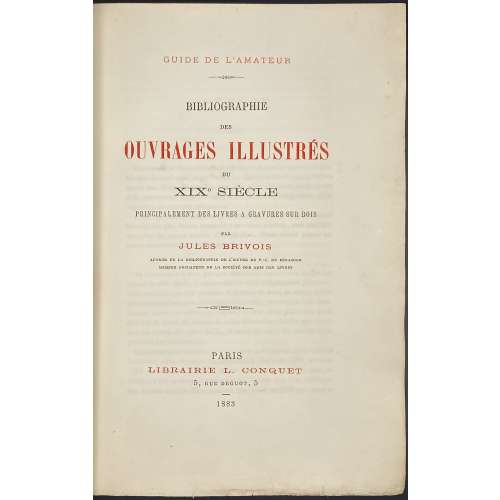 Title page: GUIDE DE L’AMATEUR | BIBLIOGRAPHIE | DES | OUVRAGES ILLUSTRES | DU | XIXe SIÈCLE | PRINCIPALEMENT DES LIVRES A GRAVURES SUR BOIS | PAR | JULES BRIVOIS | AUTEUR DE LA BIBLIOGRAPHIE DE L’ŒUVRE DE P.-J. BÉRANGER | MEMBRE FONDATEUR DE LA SOCIÉTÉ DES AMIS DES LIVRES | — | PARIS | LIBRAIRIE L. CONQUET | 5, RUE DROUOT, 5 | 1883 || Justification: Il a été tire : | 900 exemplaires sur papier vergé. | Et 50 exemplaires sur grand papier de Hollande. | Tous sont numérotés et paraphes par l’auteur. | № {188 signature} | Les numéros pairs portent le nom de M. L. Conquet. | Et les numéros impairs celui de M. P. Rouquette. | — | Le dépôt légal sera fait en France et dans tous les pays avec lesquels il | existe des conventions pour la propriété littéraire. | Tous droits réservés. || Pagination : [2] blank, [i-v] vi-xiii [xiv], [1] 2-468; the total number of pages = 484. Collation: π8 1-288 2910, an asterisk on leaf 295; the total number of leaves 242; 3 blank leaves of wove paper before and after collation. Imprint to 11 : Imp. de Mme de Lacombe; Imprint to 2910 : Nancy, imprimerie Berger-Levrault et Cie. Binding: ¾ polished distressed calf over marbled boards by the previous owner "E.D", gilt-stamped spine with gilt-lettered black label, peacock marbled endpapers, printed on laid paper. Contributors: Jules Brivois (French, 1832 – 1920) – author. L. Conquet (Paris) – publisher. P. Rouquette (Paris) – publisher. Berger-Levrault et Cie – printer.
Title page: GUIDE DE L’AMATEUR | BIBLIOGRAPHIE | DES | OUVRAGES ILLUSTRES | DU | XIXe SIÈCLE | PRINCIPALEMENT DES LIVRES A GRAVURES SUR BOIS | PAR | JULES BRIVOIS | AUTEUR DE LA BIBLIOGRAPHIE DE L’ŒUVRE DE P.-J. BÉRANGER | MEMBRE FONDATEUR DE LA SOCIÉTÉ DES AMIS DES LIVRES | — | PARIS | LIBRAIRIE L. CONQUET | 5, RUE DROUOT, 5 | 1883 || Justification: Il a été tire : | 900 exemplaires sur papier vergé. | Et 50 exemplaires sur grand papier de Hollande. | Tous sont numérotés et paraphes par l’auteur. | № {188 signature} | Les numéros pairs portent le nom de M. L. Conquet. | Et les numéros impairs celui de M. P. Rouquette. | — | Le dépôt légal sera fait en France et dans tous les pays avec lesquels il | existe des conventions pour la propriété littéraire. | Tous droits réservés. || Pagination : [2] blank, [i-v] vi-xiii [xiv], [1] 2-468; the total number of pages = 484. Collation: π8 1-288 2910, an asterisk on leaf 295; the total number of leaves 242; 3 blank leaves of wove paper before and after collation. Imprint to 11 : Imp. de Mme de Lacombe; Imprint to 2910 : Nancy, imprimerie Berger-Levrault et Cie. Binding: ¾ polished distressed calf over marbled boards by the previous owner "E.D", gilt-stamped spine with gilt-lettered black label, peacock marbled endpapers, printed on laid paper. Contributors: Jules Brivois (French, 1832 – 1920) – author. L. Conquet (Paris) – publisher. P. Rouquette (Paris) – publisher. Berger-Levrault et Cie – printer. -
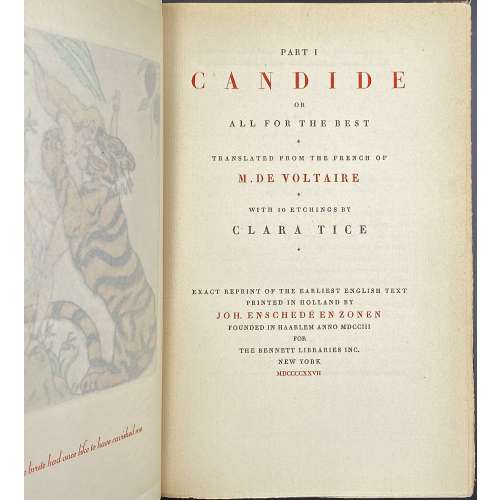 Title (in red and black): PART I | CANDIDE | OR | ALL FOR THE BEST | ★ | TRANSLATED FROM THE FRENCH OF | M. DE VOLTAIRE | ★ | WITH 10 ETCHINGS BY | CLARA TICE | ★ | EXACT REPRINT OF THE EARLIEST ENGLISH TEXT | PRINTED IN HOLLAND BY | JOH. ENSCHEDÉ EN ZONEN | FOUNDED IN HAARLEM ANNO MDCCIII | FOR | THE BENNETT LIBRARIES INC. | NEW YORK | MDCCCCXXVII || Limitation: 1,000 copies of which numbers 1 t0 250 are on a special deckle-edge Pannekoek paper; and numbers 251 to 1,000 are on papier à la cuve; this is copy № 310 (stamped in pink ink). Illustrations: 10 coloured etchings, incl. frontispiece, produced by an American artist Clara Tice (1888 – 1973) on a watermarked laid paper and bound in with tissue guards, lettered in red. Binding: 23.5 x 15.3 cm, quarter black buckram over wrinkled faux-marbled paper painted with gilt, gilt design and lettering to spine, black endpapers (both flyleaves present), top margin gilt, other trimmed rough. Collation: [10] – five blank leaves, [2] – h.t. / limitation, [2] – t.p. / imprint, 7-119 [120 blank], [121-2] – part 2 d.t.p. / blank, 123-182, [183-9] – contents, [190 blank], [10] – five blank leaves, the first blank uncut from [189/90]; total number of pages 216; total number of leaves 108 plus 10 plates with tissue guards, incl. frontispiece. Contributors: François-Marie Arouet [Voltaire] (French, 1694 – 1778)– author. Tobias George Smollett (British, 1721 – 1771) – translator (translation of 1759). Clara Tice (American, 1888 – 1973) – artist. The Bennett Libraries (NY) – publisher. Johannes Enschedé en Zonen (Haarlem) – printer.
Title (in red and black): PART I | CANDIDE | OR | ALL FOR THE BEST | ★ | TRANSLATED FROM THE FRENCH OF | M. DE VOLTAIRE | ★ | WITH 10 ETCHINGS BY | CLARA TICE | ★ | EXACT REPRINT OF THE EARLIEST ENGLISH TEXT | PRINTED IN HOLLAND BY | JOH. ENSCHEDÉ EN ZONEN | FOUNDED IN HAARLEM ANNO MDCCIII | FOR | THE BENNETT LIBRARIES INC. | NEW YORK | MDCCCCXXVII || Limitation: 1,000 copies of which numbers 1 t0 250 are on a special deckle-edge Pannekoek paper; and numbers 251 to 1,000 are on papier à la cuve; this is copy № 310 (stamped in pink ink). Illustrations: 10 coloured etchings, incl. frontispiece, produced by an American artist Clara Tice (1888 – 1973) on a watermarked laid paper and bound in with tissue guards, lettered in red. Binding: 23.5 x 15.3 cm, quarter black buckram over wrinkled faux-marbled paper painted with gilt, gilt design and lettering to spine, black endpapers (both flyleaves present), top margin gilt, other trimmed rough. Collation: [10] – five blank leaves, [2] – h.t. / limitation, [2] – t.p. / imprint, 7-119 [120 blank], [121-2] – part 2 d.t.p. / blank, 123-182, [183-9] – contents, [190 blank], [10] – five blank leaves, the first blank uncut from [189/90]; total number of pages 216; total number of leaves 108 plus 10 plates with tissue guards, incl. frontispiece. Contributors: François-Marie Arouet [Voltaire] (French, 1694 – 1778)– author. Tobias George Smollett (British, 1721 – 1771) – translator (translation of 1759). Clara Tice (American, 1888 – 1973) – artist. The Bennett Libraries (NY) – publisher. Johannes Enschedé en Zonen (Haarlem) – printer. -
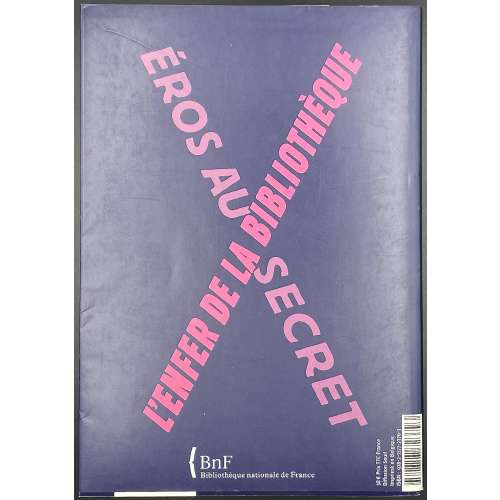 Exhibition held December 4, 2007, to March 2, 2008, at the Bibliothèque Nationale de France. Title: L'enfer de la Bibliothèque | ÉROS AU SECRET | Sous la direction | de Marie-Françoise Quignard | et Raymond-Josué Seckel | [spase] | {BnF | Bibliothèque nationale de France || Description: 23 x 16 cm, publisher’s lettered wrappers and pictorial dust jacket, [1-17] 18-460 [4], ils.; 257 entries, 8 pp. bibliography, 10 pp. index.
Exhibition held December 4, 2007, to March 2, 2008, at the Bibliothèque Nationale de France. Title: L'enfer de la Bibliothèque | ÉROS AU SECRET | Sous la direction | de Marie-Françoise Quignard | et Raymond-Josué Seckel | [spase] | {BnF | Bibliothèque nationale de France || Description: 23 x 16 cm, publisher’s lettered wrappers and pictorial dust jacket, [1-17] 18-460 [4], ils.; 257 entries, 8 pp. bibliography, 10 pp. index. -
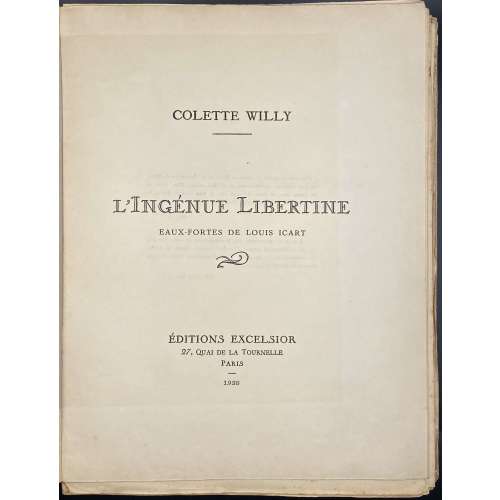 Title-page: COLETTE WILLY | — | L'ingénue libertine | EAUX-FORTES DE LOUIS ICART | ❧ | ÉDITIONS EXCELSIOR | 27, Quai de la Tournelle | Paris | 1926 || Description: French cream flapped wrappers 33.5 x 26 cm with gilt lettering to front and spine, printed on wove paper (Japon Impérial), [2] blank, [1-4] h.t. / limitation, t.p. / citations, 5-191 [3] colophon, plus 20 plates of coloured etchings and 20 plates of b/w etchings, incl. frontispiece. Edition enriched with an autograph letter signed by Colette tipped in after limitation. Edition: limited to 546 copies of which one (№ UN) is unique, printed on Papier de Chine with original colour drawings, 55 (№ 1-50 + 5 H.C.) on Japon Impérial, 65 (№ 51-100 +15 H.C.) on Hollande van Gelder, and 425 (№ 101-500 + 25 H.C.) on vergé paper BFK Rives. This copy is № 48, enriched with Colette a.l.s. and an extra suite of plates. Printed on December 3, 1926, at Arrault et Cie in Tours. Transcript of a.l.s.: "De deux romans (Minne et Les égarements de Minne) qui ne portèrent pas ma signature, j’en ai fait un seul : l’Ingénue libertine. La première partie trouve encore grâce à mes yeux ; je suis plus sévère pour la deuxième et dernière, [mot rayé] superflue et qui sent le travail. Cette libertine aurait bien dû en rester à l’ingénuité. — Colette" Contributors: Sidonie-Gabrielle Colette [a.k.a. Colette] (French, 1873 – 1954) – author. Henry Gauthier-Villars [a.k.a. Willy] (French, 1859 – 1931) – author. Louis Icart (French, 1888 – 1950) – artist.
Title-page: COLETTE WILLY | — | L'ingénue libertine | EAUX-FORTES DE LOUIS ICART | ❧ | ÉDITIONS EXCELSIOR | 27, Quai de la Tournelle | Paris | 1926 || Description: French cream flapped wrappers 33.5 x 26 cm with gilt lettering to front and spine, printed on wove paper (Japon Impérial), [2] blank, [1-4] h.t. / limitation, t.p. / citations, 5-191 [3] colophon, plus 20 plates of coloured etchings and 20 plates of b/w etchings, incl. frontispiece. Edition enriched with an autograph letter signed by Colette tipped in after limitation. Edition: limited to 546 copies of which one (№ UN) is unique, printed on Papier de Chine with original colour drawings, 55 (№ 1-50 + 5 H.C.) on Japon Impérial, 65 (№ 51-100 +15 H.C.) on Hollande van Gelder, and 425 (№ 101-500 + 25 H.C.) on vergé paper BFK Rives. This copy is № 48, enriched with Colette a.l.s. and an extra suite of plates. Printed on December 3, 1926, at Arrault et Cie in Tours. Transcript of a.l.s.: "De deux romans (Minne et Les égarements de Minne) qui ne portèrent pas ma signature, j’en ai fait un seul : l’Ingénue libertine. La première partie trouve encore grâce à mes yeux ; je suis plus sévère pour la deuxième et dernière, [mot rayé] superflue et qui sent le travail. Cette libertine aurait bien dû en rester à l’ingénuité. — Colette" Contributors: Sidonie-Gabrielle Colette [a.k.a. Colette] (French, 1873 – 1954) – author. Henry Gauthier-Villars [a.k.a. Willy] (French, 1859 – 1931) – author. Louis Icart (French, 1888 – 1950) – artist. -
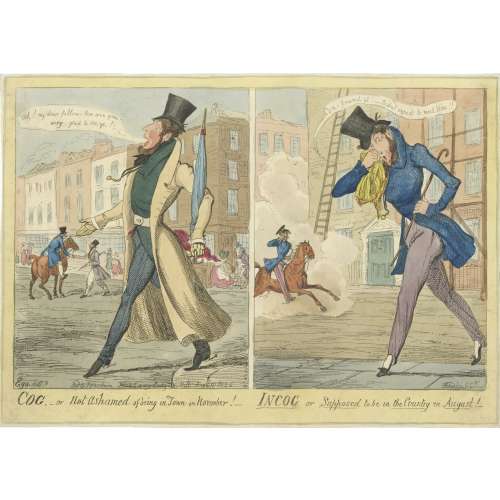 Description by British Museum (1865,1111.2128): "Two designs, side by side. [1] A dandy (probably a portrait), florid, whiskered, and bearded, steps jauntily from the pavement, hand extended, saying: Ah! my dear fellow — How are you? Devilish glad to see ye!— He holds a closed umbrella, ferrule erect, and wears a long tight-waisted coat to the heels, unbuttoned, tight pantaloons and spurred boots. In the middle distance, another dandy grasps the hand of a friend on horseback. Behind are houses with shop-fronts. A man raises his hat to a lady who curtseys. [2] The same dandy steps from the roadway onto the pavement, his handkerchief to his nose; he stoops, trying to conceal himself from a dandy cantering past in a cloud of dust, his eye-glass to his eye. He is without gloves, extraordinary for a dandy, and his trousers are strapped over pumps; he says: Con-found it! — Didn't expect to meet Him!! The street is otherwise empty; against the (large) houses are scaffolding and a tall ladder." Lettered with title, text within image including production details: 'Ego. delt / Etched by G. Ck / Pubd by J Fairburn Broadway Ludgate Hill August 18 1826'. Dimensions: Sheet: 25.5 x 36 cm, Image: 21.7 x 33.8 cm. Catalogue raisonné: A. M. Cohn (1924): № 1001, p. 262.: "A wretched plate. Difficult to believe G. C. had anything to do with it." — Bruton. Value.— £1.
Description by British Museum (1865,1111.2128): "Two designs, side by side. [1] A dandy (probably a portrait), florid, whiskered, and bearded, steps jauntily from the pavement, hand extended, saying: Ah! my dear fellow — How are you? Devilish glad to see ye!— He holds a closed umbrella, ferrule erect, and wears a long tight-waisted coat to the heels, unbuttoned, tight pantaloons and spurred boots. In the middle distance, another dandy grasps the hand of a friend on horseback. Behind are houses with shop-fronts. A man raises his hat to a lady who curtseys. [2] The same dandy steps from the roadway onto the pavement, his handkerchief to his nose; he stoops, trying to conceal himself from a dandy cantering past in a cloud of dust, his eye-glass to his eye. He is without gloves, extraordinary for a dandy, and his trousers are strapped over pumps; he says: Con-found it! — Didn't expect to meet Him!! The street is otherwise empty; against the (large) houses are scaffolding and a tall ladder." Lettered with title, text within image including production details: 'Ego. delt / Etched by G. Ck / Pubd by J Fairburn Broadway Ludgate Hill August 18 1826'. Dimensions: Sheet: 25.5 x 36 cm, Image: 21.7 x 33.8 cm. Catalogue raisonné: A. M. Cohn (1924): № 1001, p. 262.: "A wretched plate. Difficult to believe G. C. had anything to do with it." — Bruton. Value.— £1. -
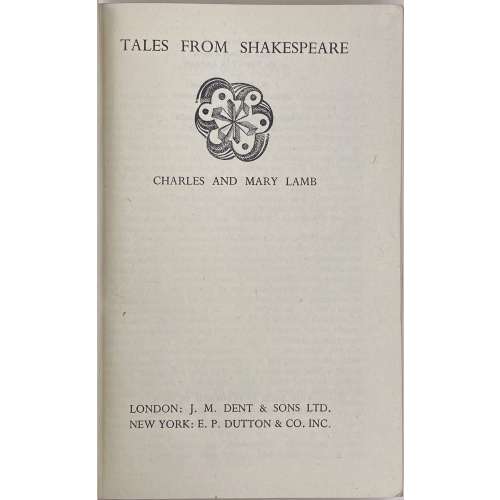 Description: 17.4 x 11 cm, blue publisher’s cloth, blind device to front board, gilt lettering to spine, no DJ, pink abstract diaper endpapers, owner’s ink inscription to ffep, dated June 28, 1945. Serial t.p.: Everyman, I will go with thee, and be thy guide, | In thy most need to go by the side. | — | EVERYMAN'S LIBRARY | EDITED BY ERNEST RHYS | No. 8 | FOR YOUNG PEOPLE | TALES FROM SHAKESPEARE | BY CHARLES AND MARY LAMB | ILLUSTRATIONS BY ARTHUR | RACKHAM || Title-page: TALES FROM SHAKESPEARE | {device} | CHARLES AND MARY LAMB | LONDON: J. M. DENT & SONS LTD. | NEW YORK: E. P. DUTTON & CO. INC. || T.p verso: All rights reserved | Made in Great Britain | at The Temple Press Letchworth | for | J. M. Dent & Sons Ltd. | Aldine House Bedford St. London | First published 1807 | First published in this edition 1906 | Last reprint (reset) 1944 | [blank] | THIS BOOK IS PRODUCED IN COM- | PLETE CONFORMITY WITH THE | AUTHORIZED ECONOMY STANDARDS || Collation: 16mo; [A]-K16; total 160 leaves, 9 full-page illustrations after Arthur Rackham, within collation (text on the other side). Pagination: [i-iv] v-viii, 1-312, total 320 pages, ils. Contributors: William Shakespeare (English, 1564 – 1616) Mary Ann Lamb (British, 1764 – 1847) – author. Charles Lamb (British, 1775 – 1834) – author. Ernest Percival Rhys (British, 1859 – 1946) – editor. Arthur Rackham (British, 1867 – 1939) – artist.
Description: 17.4 x 11 cm, blue publisher’s cloth, blind device to front board, gilt lettering to spine, no DJ, pink abstract diaper endpapers, owner’s ink inscription to ffep, dated June 28, 1945. Serial t.p.: Everyman, I will go with thee, and be thy guide, | In thy most need to go by the side. | — | EVERYMAN'S LIBRARY | EDITED BY ERNEST RHYS | No. 8 | FOR YOUNG PEOPLE | TALES FROM SHAKESPEARE | BY CHARLES AND MARY LAMB | ILLUSTRATIONS BY ARTHUR | RACKHAM || Title-page: TALES FROM SHAKESPEARE | {device} | CHARLES AND MARY LAMB | LONDON: J. M. DENT & SONS LTD. | NEW YORK: E. P. DUTTON & CO. INC. || T.p verso: All rights reserved | Made in Great Britain | at The Temple Press Letchworth | for | J. M. Dent & Sons Ltd. | Aldine House Bedford St. London | First published 1807 | First published in this edition 1906 | Last reprint (reset) 1944 | [blank] | THIS BOOK IS PRODUCED IN COM- | PLETE CONFORMITY WITH THE | AUTHORIZED ECONOMY STANDARDS || Collation: 16mo; [A]-K16; total 160 leaves, 9 full-page illustrations after Arthur Rackham, within collation (text on the other side). Pagination: [i-iv] v-viii, 1-312, total 320 pages, ils. Contributors: William Shakespeare (English, 1564 – 1616) Mary Ann Lamb (British, 1764 – 1847) – author. Charles Lamb (British, 1775 – 1834) – author. Ernest Percival Rhys (British, 1859 – 1946) – editor. Arthur Rackham (British, 1867 – 1939) – artist.Temple Press, Letchworth, England – printer.
Joseph Malaby Dent (British, 1849 – 1926) – publisher. Note: “On the writing desk were two books – identical copies of Lamb’s Tales From Shakespeare. […] — Why did you choose Lamb? — It was the only book I could find in duplicate except Uncle Tom’s Cabin…” Graham Greene. Our Man in Havana. -
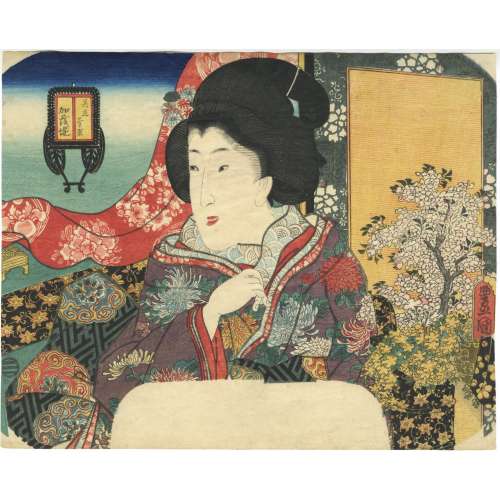 Title: On the Banks of the Kamo River [加茂堤] (Kamo Tsutsumi), sometimes transcribed as Kamo Zutsumi. Series: A Parody of Sugawara [美立菅原] (Mitate Sugawara). The word mitate is usually written as 見立 but here it is 美立, like on another Kunisada's fan print A beauty reading a book on a balcony overlooking a bay: A Parody of Sugawara Stripes (see SVJP-0334.2021 in this collection). On the Banks of the Kamo River is a scene from the play Sugawara's Secrets of Calligraphy [菅原伝授手習鑑] (Sugawara Denju Tenarai Kagami); it was originally written for the puppet theatre (Bunraku) and staged for the first time in the 8th lunar month of 1746 in Ôsaka at the Takemotoza. It was adapted for Kabuki the following month and staged for the first time in Kyôto at the Kitagawa no Shibai, produced by Nakamura Kiyosaburô I. It was also performed for the first time in Edo, at the Ichimuraza, in the 3rd lunar month of 1747. The shape of the cartouche resembles an ox cart viewed from the back which alludes to the scene Fighting for the Carriage (Kuruma biki). Artist: Utagawa Kunisada [歌川 国貞] a.k.a. Utagawa Toyokuni III [三代 歌川 豊国] (Japanese, 1786 – 1865). Signed: Toyokuni [豊国] in a red toshidama cartouche. The character ga [画] is missing (cut out). Publisher’s seal: Ibaya Senzaburō [伊場屋仙三郎] (Japanese, fl. 1815 – 1869). The date seal and censor seals were possibly trimmed out. According to [LIB-3008.2022] Andreas Marks (Tuttle, 2010; p. 267), the series was produced by Ibaya in 1851. Ref.: (1) Samuel L. Leiter. Historical dictionary of Japanese traditional theatre (Historical dictionaries of literature and the arts) / 2nd edition. – Lanham: Rowman & Littlefield, 2014©. (2) Andreas Marks. Japanese woodblock prints: Artists, publishers and masterworks, 1680 – 1900 / Foreword by Stephen Addiss. — Tuttle Publishing, 2010©. Acknowledgements: This masterpiece of ukiyo-e would not be properly described without input from Elena Varshavsky and Horst Graebner.
Title: On the Banks of the Kamo River [加茂堤] (Kamo Tsutsumi), sometimes transcribed as Kamo Zutsumi. Series: A Parody of Sugawara [美立菅原] (Mitate Sugawara). The word mitate is usually written as 見立 but here it is 美立, like on another Kunisada's fan print A beauty reading a book on a balcony overlooking a bay: A Parody of Sugawara Stripes (see SVJP-0334.2021 in this collection). On the Banks of the Kamo River is a scene from the play Sugawara's Secrets of Calligraphy [菅原伝授手習鑑] (Sugawara Denju Tenarai Kagami); it was originally written for the puppet theatre (Bunraku) and staged for the first time in the 8th lunar month of 1746 in Ôsaka at the Takemotoza. It was adapted for Kabuki the following month and staged for the first time in Kyôto at the Kitagawa no Shibai, produced by Nakamura Kiyosaburô I. It was also performed for the first time in Edo, at the Ichimuraza, in the 3rd lunar month of 1747. The shape of the cartouche resembles an ox cart viewed from the back which alludes to the scene Fighting for the Carriage (Kuruma biki). Artist: Utagawa Kunisada [歌川 国貞] a.k.a. Utagawa Toyokuni III [三代 歌川 豊国] (Japanese, 1786 – 1865). Signed: Toyokuni [豊国] in a red toshidama cartouche. The character ga [画] is missing (cut out). Publisher’s seal: Ibaya Senzaburō [伊場屋仙三郎] (Japanese, fl. 1815 – 1869). The date seal and censor seals were possibly trimmed out. According to [LIB-3008.2022] Andreas Marks (Tuttle, 2010; p. 267), the series was produced by Ibaya in 1851. Ref.: (1) Samuel L. Leiter. Historical dictionary of Japanese traditional theatre (Historical dictionaries of literature and the arts) / 2nd edition. – Lanham: Rowman & Littlefield, 2014©. (2) Andreas Marks. Japanese woodblock prints: Artists, publishers and masterworks, 1680 – 1900 / Foreword by Stephen Addiss. — Tuttle Publishing, 2010©. Acknowledgements: This masterpiece of ukiyo-e would not be properly described without input from Elena Varshavsky and Horst Graebner. -
![Война мышей и лягушек. Батрахомиомахия / Пер. с древнегреческого, вводн. стат. и коммент. М.С.Альтмана. Иллюстр. А. И. Порет, переплет и обложка по ее же рисункам. С суперобложкой. — М.-Л.: Academia, 1936. — XV, [I], 21, [2] стр. (Античная литература под общей ред. Д. А. Горбова и В. О. Нилендера.](https://varshavskycollection.com/wp-content/uploads/2021/02/LIB-0985.2016-a-scaled-500x500.jpeg) Description: white paper hardcover, lettered to front, 25.8 x 18 cm, in pictorial dust jacket; pagination: [i-vi] vii-xv [xvi] [2] 3-21 [3], errata slip bound in; one folding plate bound in after p.8. Title-page: ВОЙНА | МЫШЕЙ И ЛЯГУШЕК | (БАТРАХОМИОМАХИЯ) | Перевод с древнегреческого, | вводная статья | и комментарии | М. С. АЛЬТМАНА | ACADEMIA | 1936 || Opposite title: АНТИЧНАЯ ЛИТЕРАТУРА | под общей редакцией | Д. А. ГОРБОВА И В. О. НИЛЕНДЕРА | БАТРАХОМИОМАХИЯ | ACADEMIA | Москва – Ленинград || Title verso: ΒΑΤΡΑΧΟΜΥΟΜΑΧΊΑ | Иллюстрация А. И. Порет | Переплет и суперобложка | по ее же рисункам || Print run: 10,300 copies. Catalogue raisonné: Крылов-Кичатова № 798, p. 274. Contributors: Альтман, Моисей Семёнович (Russian-Jewish, 1896—1986) – translator, author Порет, Алиса Ивановна (Russian, 1902 – 1984) – artist.
Description: white paper hardcover, lettered to front, 25.8 x 18 cm, in pictorial dust jacket; pagination: [i-vi] vii-xv [xvi] [2] 3-21 [3], errata slip bound in; one folding plate bound in after p.8. Title-page: ВОЙНА | МЫШЕЙ И ЛЯГУШЕК | (БАТРАХОМИОМАХИЯ) | Перевод с древнегреческого, | вводная статья | и комментарии | М. С. АЛЬТМАНА | ACADEMIA | 1936 || Opposite title: АНТИЧНАЯ ЛИТЕРАТУРА | под общей редакцией | Д. А. ГОРБОВА И В. О. НИЛЕНДЕРА | БАТРАХОМИОМАХИЯ | ACADEMIA | Москва – Ленинград || Title verso: ΒΑΤΡΑΧΟΜΥΟΜΑΧΊΑ | Иллюстрация А. И. Порет | Переплет и суперобложка | по ее же рисункам || Print run: 10,300 copies. Catalogue raisonné: Крылов-Кичатова № 798, p. 274. Contributors: Альтман, Моисей Семёнович (Russian-Jewish, 1896—1986) – translator, author Порет, Алиса Ивановна (Russian, 1902 – 1984) – artist. -
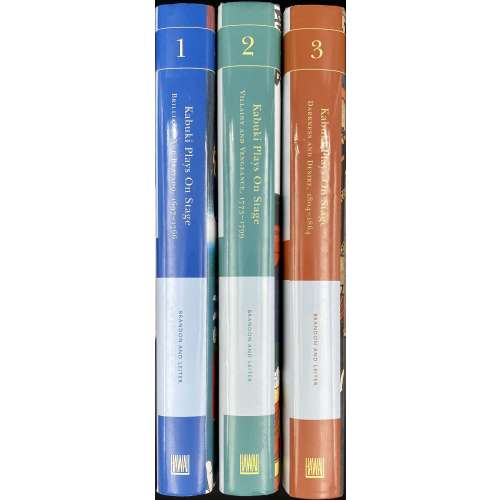 Three volumes, 26.2 x 18.6 cm each: Vol. 1: Kabuki plays on stage: Brilliance and Bravado, 1697-1766; pp.: [i-viii] ix-xiii [xiv blank], 1-391 [1 blank], total 203 leaves, ils. Blue buckram gilt-lettered on spine, pictorial DJ. Vol. 2: Kabuki plays on stage: Villainy and Vengeance, 1773-1799; pp.: [i-viii] ix-xiii [xiv blank], 1-413 [3 blank], total 215 leaves, ils. Green buckram gilt-lettered on spine, pictorial DJ. Vol. 3: Kabuki plays on stage: Darkness and Desire, 1804-1864; pp.: [i-viii] ix-xv [xvi blank], [1] 2-397 [3 blank], total 208 leaves, ils. Ochre buckram gilt-lettered on spine, pictorial DJ. (Vol. 4: Restoration and reform, 1872-1905 – absent for the reason of no interest in the covered period). Contributors: James Rodger Brandon (American, 1927 – 2015) Samuel L. Leiter (American, b. 1940)
Three volumes, 26.2 x 18.6 cm each: Vol. 1: Kabuki plays on stage: Brilliance and Bravado, 1697-1766; pp.: [i-viii] ix-xiii [xiv blank], 1-391 [1 blank], total 203 leaves, ils. Blue buckram gilt-lettered on spine, pictorial DJ. Vol. 2: Kabuki plays on stage: Villainy and Vengeance, 1773-1799; pp.: [i-viii] ix-xiii [xiv blank], 1-413 [3 blank], total 215 leaves, ils. Green buckram gilt-lettered on spine, pictorial DJ. Vol. 3: Kabuki plays on stage: Darkness and Desire, 1804-1864; pp.: [i-viii] ix-xv [xvi blank], [1] 2-397 [3 blank], total 208 leaves, ils. Ochre buckram gilt-lettered on spine, pictorial DJ. (Vol. 4: Restoration and reform, 1872-1905 – absent for the reason of no interest in the covered period). Contributors: James Rodger Brandon (American, 1927 – 2015) Samuel L. Leiter (American, b. 1940) -
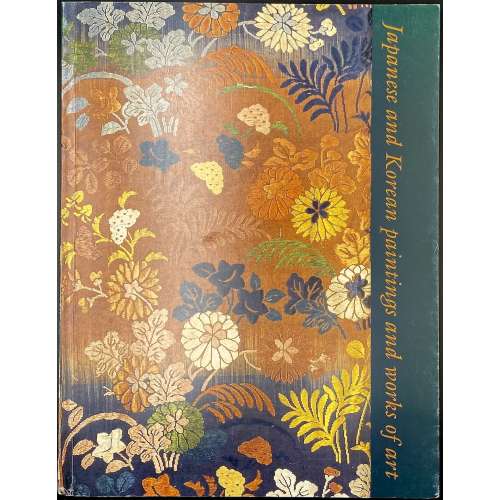 Softcover, in flapped pictorial wrappers, 28 x 21.6 cm, 35 entries, with colour illustrations. Catalogue # 6 of the sales exhibition on March 19-24, 2002 in NY; pagination: [1-3] 4-82 [2], ils., some folding. Contributor: Sebastian Izzard
Softcover, in flapped pictorial wrappers, 28 x 21.6 cm, 35 entries, with colour illustrations. Catalogue # 6 of the sales exhibition on March 19-24, 2002 in NY; pagination: [1-3] 4-82 [2], ils., some folding. Contributor: Sebastian Izzard -
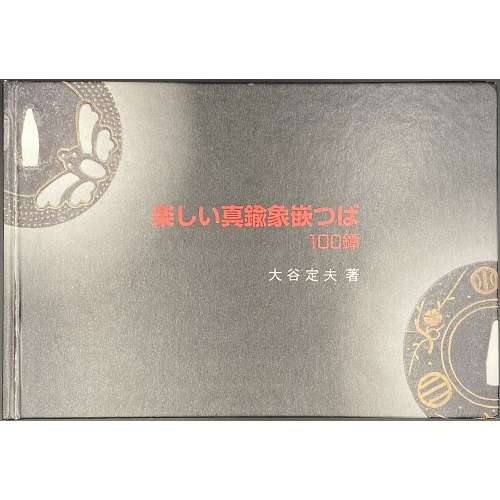 Description: Hardcover oblong volume 16 x 23.3 cm with black pictorial paper boards lettered in red and white to front cover and spine, in an ochre slipcase sprinkled brown and lettered in black to front and spine; grey endpapers, pp. [2] 3-130 [2], with a bookshop ticket to back pastedown “ISSHINDō”. Illustrated descriptions of 100 Japanese sword handguards (tsuba) with brass inlay. Title-page: 楽しい真鍮象嵌つば | 100 鐔 | 大谷定夫著 [Tanoshii Shinchū-Zōgan Tsuba | Hyakutan | Ōya Sadao cho] (Enjoying Brass Inlay Sword Guards | 100 Sword Guards | Author: Ōya Sadao) Colophon: Published December 15, 1999 Price: ¥3,800 (base price ¥3,619) Author: Ōya Sadao (大谷定夫) Producer: Ōtsuka Kōgeisha International Publisher: Ōtsuka Kōgeisha Co. Ltd. (大塚工藝社)Phone 103–0016 Tōkyō-to, Chūō-ku, Nihonbashi Koami-chō 1–5 Tel. 03–5642–3511 (Representative) Fax 03–5642–3618 Design: Takahashi Tōru (高橋享) Photography: Kitami Noboru (北見登) Kishioka Yasuhiro (岸岡保弘) ISBN4–900298–03–4 C0072 ¥3619E Subject: Ōnin tsuba; Heianjō tsuba; Suemon-zōgan; Ten-zōgan; Japanese sword handguards; Japanese sword fittings; Tosogu.
Description: Hardcover oblong volume 16 x 23.3 cm with black pictorial paper boards lettered in red and white to front cover and spine, in an ochre slipcase sprinkled brown and lettered in black to front and spine; grey endpapers, pp. [2] 3-130 [2], with a bookshop ticket to back pastedown “ISSHINDō”. Illustrated descriptions of 100 Japanese sword handguards (tsuba) with brass inlay. Title-page: 楽しい真鍮象嵌つば | 100 鐔 | 大谷定夫著 [Tanoshii Shinchū-Zōgan Tsuba | Hyakutan | Ōya Sadao cho] (Enjoying Brass Inlay Sword Guards | 100 Sword Guards | Author: Ōya Sadao) Colophon: Published December 15, 1999 Price: ¥3,800 (base price ¥3,619) Author: Ōya Sadao (大谷定夫) Producer: Ōtsuka Kōgeisha International Publisher: Ōtsuka Kōgeisha Co. Ltd. (大塚工藝社)Phone 103–0016 Tōkyō-to, Chūō-ku, Nihonbashi Koami-chō 1–5 Tel. 03–5642–3511 (Representative) Fax 03–5642–3618 Design: Takahashi Tōru (高橋享) Photography: Kitami Noboru (北見登) Kishioka Yasuhiro (岸岡保弘) ISBN4–900298–03–4 C0072 ¥3619E Subject: Ōnin tsuba; Heianjō tsuba; Suemon-zōgan; Ten-zōgan; Japanese sword handguards; Japanese sword fittings; Tosogu. -
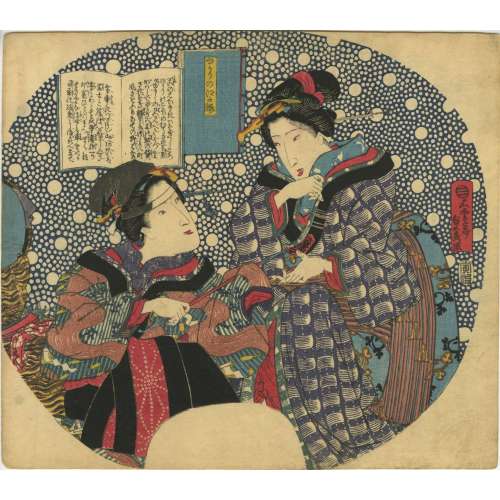 Artist: Utagawa Sadahide [歌川 貞秀], a.k.a. Gountei Sadahide [五雲亭 貞秀] (1807 – c. 1878/9). Signed: Gountei Sadahide ga [五雲亭貞秀画] Pubisher: Ibaya Senzaburō [伊場屋仙三郎] (Japanese, 1815 – 1869) Date-aratame seal: Bunsei 13 / Tenpō 1 (1830). Ref: Ritsumeikan University # Z0172-587. Title: Yukari no Edo-zakura [ゆかりの江戸桜], often translated into English as 'The Flower of Edo', is a one-act kabuki play Sukeroku, written by Tsuuchi Han'emon (fl. 1701 – 1743) under the supervision of Tsuuchi Jihei II (1673 – 1760 ) at the beginning of the 18th century. From the beginning of the 19th century, the play was performed in the style of katōbushi. 助六所縁江戸桜(すけろくゆかりのえどざくら。「助六」– one of the main melodies in katōbushi (河東節) type of jōruri [浄瑠璃]. For a detailed explanation in Japanese, see also HERE). Plot: In search of the stolen Minamoto clan's precious sword called Tomokirimaru, Soga Gorō (historical Soga Tokimune [曾我時致], 1174 – 1193) came to a Yoshiwara brothel under the disguise of a debaucher named Hanagawado Sukeroku. His elder brother, Soga Jūrō (historical Soga Sukenari [曾我祐成], 1172 – 1193) ), has assumed the guise of a wine vendor Shinbei. The character who had the Tomokirimaru sword was Ikyū (historical Iga no Heinaizaemon, a Tiara clan's ally), see SVJP-0164.2014. A series of three prints is dedicated to a katōbushi performance of the Soga-themed plays.
Artist: Utagawa Sadahide [歌川 貞秀], a.k.a. Gountei Sadahide [五雲亭 貞秀] (1807 – c. 1878/9). Signed: Gountei Sadahide ga [五雲亭貞秀画] Pubisher: Ibaya Senzaburō [伊場屋仙三郎] (Japanese, 1815 – 1869) Date-aratame seal: Bunsei 13 / Tenpō 1 (1830). Ref: Ritsumeikan University # Z0172-587. Title: Yukari no Edo-zakura [ゆかりの江戸桜], often translated into English as 'The Flower of Edo', is a one-act kabuki play Sukeroku, written by Tsuuchi Han'emon (fl. 1701 – 1743) under the supervision of Tsuuchi Jihei II (1673 – 1760 ) at the beginning of the 18th century. From the beginning of the 19th century, the play was performed in the style of katōbushi. 助六所縁江戸桜(すけろくゆかりのえどざくら。「助六」– one of the main melodies in katōbushi (河東節) type of jōruri [浄瑠璃]. For a detailed explanation in Japanese, see also HERE). Plot: In search of the stolen Minamoto clan's precious sword called Tomokirimaru, Soga Gorō (historical Soga Tokimune [曾我時致], 1174 – 1193) came to a Yoshiwara brothel under the disguise of a debaucher named Hanagawado Sukeroku. His elder brother, Soga Jūrō (historical Soga Sukenari [曾我祐成], 1172 – 1193) ), has assumed the guise of a wine vendor Shinbei. The character who had the Tomokirimaru sword was Ikyū (historical Iga no Heinaizaemon, a Tiara clan's ally), see SVJP-0164.2014. A series of three prints is dedicated to a katōbushi performance of the Soga-themed plays.
They all have a background of hail patterns (Arare-ko-mon) [霰小紋], similar to Kunisada’s Iwai Kumesaburō II as An no Heibei [SVJP-0304.2019], see below.Yukari no Edo-zakura The tatami night robe of Iwao Tangled Hair and the Evening Braided Hat 





